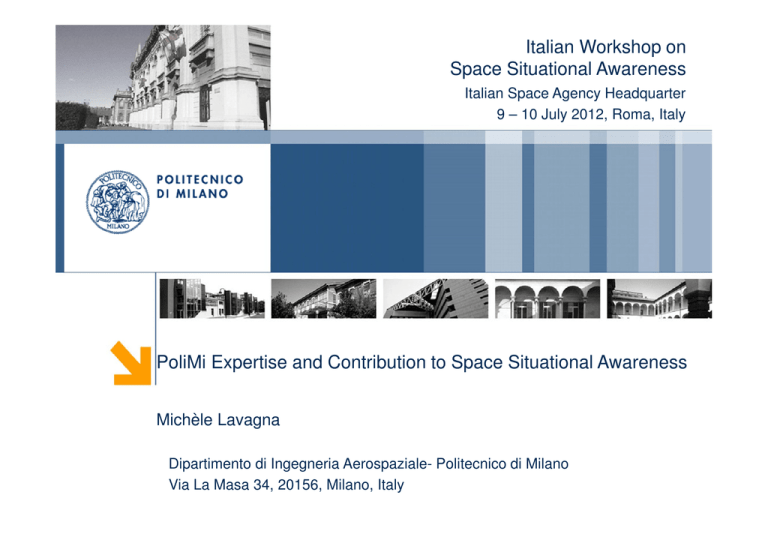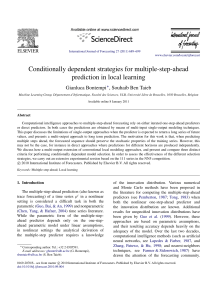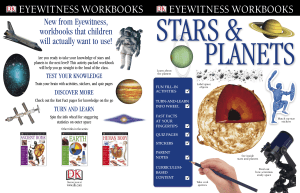
Italian Workshop on
Space Situational Awareness
Italian Space Agency Headquarter
9 – 10 July 2012, Roma, Italy
PoliMi Expertise and Contribution to Space Situational Awareness
Michèle Lavagna
Dipartimento di Ingegneria Aerospaziale- Politecnico di Milano
Via La Masa 34, 20156, Milano, Italy
Team Members and Roles
‣ Politecnico di Milano
Name
Role
Email
Michèle Lavagna
Associate Professor
[email protected]
Roberto Armellin
Postdoctoral Fellow
[email protected]
Pierluigi Di Lizia
Postdoctoral Fellow
[email protected]
Monica Valli
PhD Student
[email protected]
Alessandro Morselli
PhD Student
[email protected]
Chiara Massimiani
PhD Student
[email protected]
‣ Dinamica Srl
Name
Role
Email
Michèle Lavagna
Partner
[email protected]
Roberto Armellin
Partner
[email protected]
Pierluigi Di Lizia
Partner
[email protected]
Research Areas and Collaborations
‣
‣
Past and ongoing work on both NEO and Space Debris
Rationales and Curriculum:
2005
Participation to ESA/Ariadna study:
• Interval analysis and validated integration techniques
• Assessment of their accuracy for error and uncertainty propagation in
astrodynamics
2006
Collaboration with Michigan State University (Berz)
• High order methods: Differential algebra
and Taylor models
• Initially developed for particles
•
accelerators
Proposed by R. Moore to perform
validated integration of NEO motion
• Extremely useful for global optimization
Research Areas and Collaborations
2007
2009
Participation to two ESA/Ariadna studies
• Branch and bound global optimization;
application to MOID computation
• Nonlinear tools for uncertainty propagation
with applications to Apophis
2009
Interest shown by ESA (Granada, 2009) paved
the way to applications in Space Debris sector
• Nonlinear mapping of uncertainties in preliminary orbit determination
• Fast conjunction analysis and impact probability computation
2010
2011
Collaboration with Università di Bologna (Piergentili), Università di Padova
(Francesconi), Università di Roma (Santoni) for Active Debris Removal
2012
• Participation to the ITN “The Asteroid and Space Debris Network” (FP7)
• Collaboration with INAF-IRA: Debris orbit determination with Croce del
•
Nord radiotelescopes
Support to the definition of an SSA/NEO architecture in CO-II (Telespazio)
Previous Work and Main Results
‣
Nonlinear tools for uncertainty propagation
for NEO and Debris
• NEO/Debris state is Taylor expanded in initial conditions
• Integrations replaced by evaluations of polynomials
Fast Monte Carlo simulation:
Computational time reduced to 1%
•
Polynomials are manipulated to obtain time and distance of
close approach as a function of initial conditions
Accurate and fast computation of impact probability
‣
MOID computation
• The use of rigorous global optimizers guarantees that
the exact MOID is computed
•
•
The algorithm is able to handle multiple solutions
The Taylor expansion of the MOID w.r.t. uncertain
parameters is computed
MOID range including uncertainties
Previous Work and Main Results
‣
Orbit determination
• Uncertainties are taken into account throughout the
orbit determination process
Nonlinear mapping of uncertainty in NEO state
•
Subsequent high order propagation improves accuracy
for NEO follow-up
Finer enclosure of the region to be observed
•
‣
Fast nonlinear filtering techniques have been developed
to improve accuracy with additional observations
Active Debris Removal
• Robustness analysis to uncertainties on boundary
•
•
•
conditions and model parameters
Nonlinear optimal feedback control algorithms for
uncertain boundary conditions (noncooperative debris)
Optimal control laws robust to uncertain model parameters
Capture mechanisms: docking, net, expanding foam
Implemented Methods
‣ The implemented algorithms are based on differential algebra (DA)
Algebra of
real numbers
Algebra of
Taylor polynomial
‣ DA allows semi-analytical, nonlinear, and efficient mapping of uncertainties (e.g.
high order expansion of the flow of ODE)
‣ When nonlinearities play a crucial role
‣ DA enables algorithms that are more accurate than those based on linearizations
‣ DA enables algorithms that are more efficient than classical Monte Carlo
simulation (orders of magnitude) with comparable accuracy
‣ In combination with interval analysis validated propagation and rigorous global
optimization
Implemented Methods
Debris
‣Tool for computing the weekly collision risk between all operative
satellites against a list of all unclassified USSTRATCOM two-line
element (TLE) sets (first guess)
‣Orbital filters for reducing the number of pairs to be analyzed
‣Verified global optimizer for computing the time and distance of closest
approach (TCA and DCA)
‣Analytical and nonlinear mapping of uncertainties on TCA and DCA
‣Efficient algorithms for computation of collision probabilities combining the
Taylor expansion of TCA and DCA and sampling techniques
‣Refinement in more accurate dynamical (numerical) model
‣Methods for nonlinear mapping of observation uncertainties from the
space of observables to phase space
‣High-order filters for accurate orbit determination
Implemented Methods
NEO
‣Algorithms for analyzing NEO trajectories
‣Identification of potentially hazardous objects (PHO) via rigorous
computation of MOID
‣Rigorous computation of the time and distance of closest approach (TCA
and DCA)
‣Analytical and nonlinear mapping of uncertainties on TCA and DCA
‣Highly accurate expansion of the flow to study close approaches, resonant
returns, and for computation of collision probabilities
‣Mapping observation uncertainties from the space of observables to
phase space in preliminary orbit determination
‣High-order filters for accurate orbit determination
Potentialities - Limitation
Potentialities
‣Efficient algorithms for the management of uncertainties in orbit determination
and orbit propagation
‣Alternative approach to current ones (independent cross-validation of the result
often pursued by ESA)
‣Inclusion in consolidated tools to extend some capabilities and improve
performances
Limitations
‣Most of the codes is the result of research activity, scientific publications have
been produced
‣DA is implemented in COSY-Infinity (open source), a constraint on computer
language
Funds are needed for software engineering (mandatory) and for DA
implementation in a different working environment (nice to have)
Unexploited Potentials
‣ Differential algebra has unexploited potentials in
‣ Debris clouds (post-collision) evolution in arbitrary dynamical model
‣ Enrich TLE with confidence region information
‣ Development of alternatives to TLE and SGP4 for orbital parameters
storage and objects orbit propagation
‣ Expand the flow of ODE with respect to uncertain parameters (e.g.
diameter, spin axis direction, and thermal properties for NEO
propagation) or un-modeled perturbation (unknown, but bounded)
‣ Include information on uncertain parameters (not only initial condition)
in computation of collision probabilities
Contribution to SSA
‣ Started a collaboration with Medicina Observatory
‣ Current activity: support for target selection for observation with a small
portion of the Croce del Nord
‣ Future goal: orbit determination for the full scale use of re-engineered Croce
del Nord
Medicina
Medicina
Radar survey
and follow-up
Data processing
PoliMi
Orbit determination
and propagation
Catalogue Maintenance
PoliMi
Risk Assessment
Contribution to SSA
‣ TOols for Management of Close Approach Threats (TOMCAT)
• Main goals: accurate impact risk assessment and design of optimal collision
avoidance maneuvers
CA ident.
UniRM
UniBO
MOID
& IP
PoliMI
UniRM
Optical & radar
measurements
UniBO
Improved
OD
UniRM, UniBO
PoliMI
Risk
UniPD
Collision
avoidance
PoliMI
‣ CO-II SSA Architectural Design (collaboration with Telespazio and INAF- OAB)
• Main goals: consolidated architecture for civilian SSA with programmatic dossier
Req.
analysis
Candidate architectures
identification
Supporting
analysis
Development, deployment,
and operation approach
Active debris removal
‣ Space system design
‣ Pre-phase A studies for debris removal missions
‣ Rendezvous and docking
‣ Robust control algorithms
‣ Facility for 2D algorithms testing: frictionless table
‣ Proposals to MIUR in collaboration with Uni PD, UniBO,
UniNA “Federico II”, Uni RM “La Sapienza”
Active Debris Removal
‣ Catching mechanism
‣ Net system design and testing
‣ Expressed interest by ESA and
contact with Astrium where similar
activities are undergoing
‣ De-orbiting mechanism
‣ Hybrid propulsion for de-orbiting
FOTO e
dettagli



